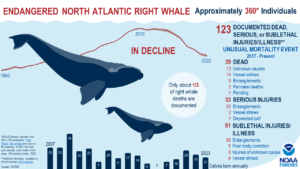
By Steve Haner
A coalition of public interest groups has now filed its expected lawsuit seeking to halt construction of Dominion Energy Virginia’s offshore wind facility off Virginia Beach. Its key complaint is the federal permits were issued without a full and fair evaluation of the potential impact of the turbines on the shrinking North Atlantic Right Whale population.
The Heartland Institute, based in Illinois, the Committee for a Constructive Tomorrow, with offices in Washington, D.C. and the National Legal and Policy Center of Falls Church, along with two individuals, are the listed plaintiffs. The Bureau of Ocean Energy Management (BOEM) and National Marine Fisheries Service (NMFS) and federal office holders are among the named defendants, along with Dominion.
The 61-page complaint to a District of Columbia federal court seeks relief under the Endangered Species Act. It claims the law requires the federal government to study the combined impact of all the planned East Coast wind projects, from New England waters down to North Carolina’s outer banks. Instead, the federal permitting authorities to date have looked at individual projects without regard to cumulative effects when issuing wildlife impact opinions and permits.
From the article on the CFACT website:
This Dominion Energy project is but one of many massive offshore wind projects mandated by an executive order issued by President Biden on January 27, 2021, declaring that a “climate crisis” exists that “threatens mankind’s existence.” The Biden administration has given fast-track approval to dozens of wind projects off the East Coast, with the goal of producing 30 gigawatts of electricity by 2030.
In issuing its “biological opinion” in September, NMFS only examined the impact that each of these projects, individually and in isolation, would have on the North Atlantic right whale. The agency did not, as it should have, issue a comprehensive and cumulative analysis examining the combined harm that all of the projects, together, would inflict on the whales during their annual migration path.
The courts, including the federal courts of the District of Columbia, have uniformly ruled that this approach is illegal in other endangered species cases because it misconstrues the language of the Endangered Species Act and creates, in the words of one court, “a type of slow slide into oblivion that is one of the very ills the Endangered Species Act was designed to prevent.”
The amount of federal waters leased for these projects constitutes an area larger than the states of Rhode Island and Connecticut combined. The North Atlantic right whales would be forced to navigate a gauntlet of 32 separate lease areas from Georgia to Maine twice each year.
This lawsuit would cause Dominion to halt construction on the project until BOEM has developed a new “biological opinion”, providing verifiable protection against potential harm to the North Atlantic right whale caused by these projects.
A total of 55 dead right whales have washed up on the beaches of the East Coast since 2017, causing the federal authorities to declare an “unusual mortality event” and create two areas of “critical habitat” for the whale – one off the coast of Maine and one off the coast Georgia. The North Atlantic right whale is a critically endangered species with only about 70 females capable of producing newborn calves.
The North Atlantic right whale is so critically endangered that NMFS has issued a determination for the chances of survival for the species called the Potential Biological Removal Rate (PBR). The PBR for the NARW is 0.7, which means that if the species is to survive, there must be zero human-caused mortalities of the NARW on an annual basis.
Construction of the 176-turbine project is moving forward, with the utility continuing to state it will be placing monopiles in the water soon and will complete the project for the projected $10 billion. Should it be cancelled, the utility and its stockholders will still be entitled to collect any and all costs incurred to date from the company’s 2.6 million Virginia ratepayers.
Federal subsidies for the project would not materialize if it is not built, so all the stranded costs would fall on ratepayers. Should the case even succeed in forcing a substantial delay in the company’s construction schedule, that will increase the final cost to those ratepayers.
Even for those who strongly opposed the project before it received favorable legislation from the Virginia General Assembly and its State Corporation Commission approvals, this lawsuit is ambivalent news.

Leave a Reply
You must be logged in to post a comment.